The first major land battle in the Crimean War - the battle of Alma. Part of 2
Early in the morning of 8 (20) of September 1854, the French forces, under the command of General Pierre Bosquet, moved around the left flank of the Russian army. In the French-Turkish corps there were 14 thousand soldiers. According to the plan, Bosque was supposed to divert the attention of the Russians when the center was hit by St. Arnaud. At this time, the British were to capture Kurgan Hill on the right flank.
However, the British were in no hurry, so Bosque was forced to stop for a rest. In 12 hours, the offensive has resumed. Ahead was a chain of shooters - the Zouaves and the Algerians. Behind them are two columns: in the left column was the 1-I brigade, in the right column 2-I brigade of General Bois, she was advancing along a sandbank at the mouth of the river. Behind them was the Turkish division.
Help. In the French colonial troops, Zouawas called servicemen of elite light infantry units. They were recruited mainly from residents of North Africa, as well as French volunteers. The name "Zuavy" originated from Fr. the words zouave, the so-called Berber tribe, living in the region of Kabylie in the north of Algeria.
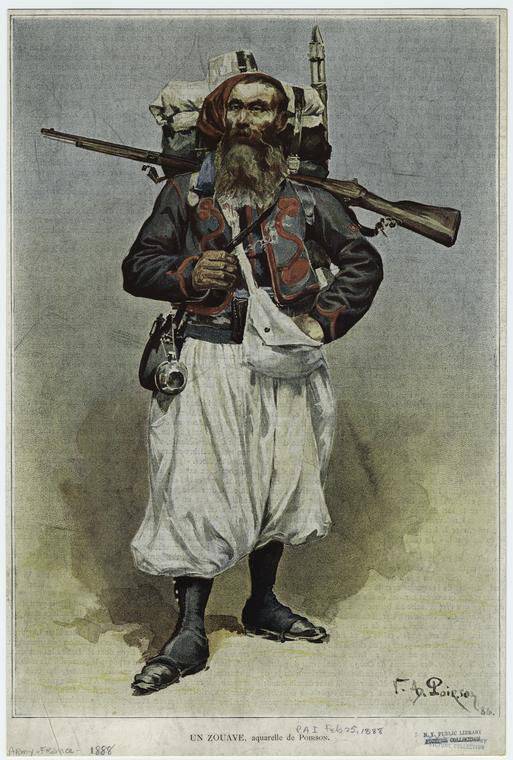
Zuav. 1888 year
The rifle chain forced the river and freely climbed the heights of the right bank of Alma. This surprised Bosque, as the place was ideal to meet the enemy. Then they were waited by another pleasant surprise. In front of them were elevations, in places completely sheer. With appropriate engineering training, they became completely inaccessible, especially for raising artillery. Bosque ordered to take the heights, but it turned out that they were not reinforced properly and no one protects them. There were only Cossack patrols, who immediately left, having discovered such a mass of enemy troops.
Concerning further events there is no single picture. According to one version, the most common, the French arrows penetrated into the rear of the 2 Battalion of the Minsk Regiment. The battalion mixed up and, on orders, Lieutenant Colonel Rakovich left behind the village of Orta-Kisek.
According to the contemporaries of the battle of I. F. Prikhodkin (Prikhodkin I. F. Alminskoye battle), after the appearance of the French on the left flank, Menshikov turned the Moscow and Minsk regiments there. As a result, the left flank of the Russian army was bent at a right angle. The Belostok, Brest and Tarutinsky regiments held positions in the center.
On the left flank of the 5 Russian battalions met the 10 battalions of the French division of Bosque. However, the Russian infantry was supported by artillery, and the French artillery fell behind. It was difficult to transfer it over rough terrain. The French went on the attack and suffered heavy losses under the deadly fire of the Russian artillery. Our artillery destroyed the French in whole ranks, but they bravely continued to advance. When they came at a distance of a rifle shot, their superiority in small arms came to life. Moreover, under one of the versions, at the same time, the allied fleet opened fire, from which the Minsk regiment suffered heavy losses. Russian troops steadfastly resisted. We went to bayonet attacks. As the witness of the battle noted, “there was plenty of bayonets, but the Russian butts too!” Then one more error became clear, the batteries had few charges. Spare charging boxes placed at a great distance, for fear of hitting them.
The lack of field artillery prevented the French from finally deciding the outcome of the case on the left flank in their favor. At this time, on the left flank, the river was crossed by another French division under the command of General Canrobert. She dropped the advanced units of the Moscow regiment and began to threaten the entire left flank. Now Boske’s troops could not be dropped by the available forces and the situation on the left flank became critical. At the same time, the French were able to raise guns on the plateau and opened fire on Russian positions. Russian soldiers were forced to move somewhat. At the same time, the Russian regiments also moved away in the center.
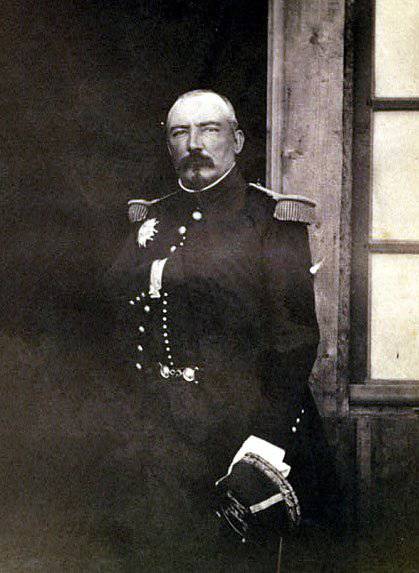
General Pierre Francois Joseph Bosquet (1810 - 1861)
Center
The French forces in the center, the 1-I and 3-I French divisions (20 battalions), launched an offensive around 6 in the morning. Ahead went arrows Zouavy. The arrows of the Moscow regiment moved away, leaving the village of Almatamak on the left bank of the river. The French forced the river. As a result, the detached regiments of the Russian left flank — the Moscow and Minsk regiments — fell between two fires.
The 2 and 3 battalions of the Moscow regiment opened fire on the Canrober division. The French suffered some casualties, and General Canrober was injured. To support the offensive, Marshal St. Arnaud threw 3-th reserve division into battle. At about 14 hours, Russian troops began to retreat. Both commanders of the Russian Minsk and Moscow regiments, Prikhodkin and Kurtyanov, were wounded. The Bialystok, Brest and Tarutinsky regiments, which were supposed to hold their positions in the center, retreated without much resistance. They were demoralized by the view of the retreating troops of the left flank. In addition, came under artillery shelling. Only the Borodino Regiment courageously fought off attacks by the enemy in the center (here the Lacy Evans division was advancing) and rejected the British for Burliuk. Only having lost half of the composition, the regiment retreated.
As a result, only the right-flank battalions of the Moscow regiment remained to protect the key position of the center. I must say that according to English data, this hill was not protected at all. Lord Raglan, in search of a convenient position for observation, went to the location of the French troops and occupied Telegraph Hill. Assessing his convenience, he ordered a battery on it. The Allied battery fired on the right-flank Vladimir regiment, which at that moment was just advancing towards the river. Having fallen under flanking fire, the regiment stopped the attack and withdrew.
According to the Russian version, units of the Moscow regiment on the Telegraph Hill had the last resistance to the enemy. The French took the height by storm. Russian soldiers, after a stubborn struggle, were forced to concede numerically superior enemy. After that, the French were taken to the hill 42 guns (seven batteries). The Minsk regiment also to the last resisted the enemy and retreated only when he learned about the withdrawal of the entire army. The regiment commander gave the order to retreat.
Source: Bloodless L. Atlas of maps and schemes for the Russian military stories
Right flank
British troops also marched in the morning. They had to make a workaround. However, during the movement it turned out that bypassing the Russian flank would create a dangerous gap between the troops. Lord Raglan ordered the divisions to shift to the right. As a result, the British not only launched an offensive a few hours later than planned, but also launched a frontal attack, instead of a flank attack. If it were not for the success of the French troops, the British on that day could be defeated.
British troops attacked in two lines. The first was the light division led by George Brown (left wing) and the 2 division of George de Lacy Evans (right wing). In the second line, the 1 Division of the Duke of Cambridge (left wing) and the 3 Division of Richard Ingland (right wing) were advancing. The 4 division of George Katkart and the cavalry of Count Lucan remained in reserve.
Brown's division attacked Kurgan Hill, which defended the Kazan regiment of Chasseurs. Here are located the redoubts - Bolshoi and Malyi. They were held by Vladimirsky and Uglitsky regiments. On the right wing was the Suzdal regiment. The troops on Kurgan Hill were led by the commander of the 17 Division, General Onufry Alexandrovich Kvitsinsky. It was an experienced combat commander who participated in many battles of 1812 — 1814.
In the course of the movement, the orders of the British first-line divisions were mixed, the officers could not restore order and the troops went on the attack by a poorly organized mob. The British began to climb up the slope when they were attacked by the 8 and 4 battalions of the Kazan Chasseur Regiment. However, this attack did more harm than good. The attacking rangers prevented the Russian artillery from firing at the enemy. In addition, when they were overturned by strong rifle fire (regiment commander Seleznev and both battalion commanders died), the British on their shoulders broke into the Great Redoubt. With delay, the Russian artillery opened fire on the enemy, but because of the uneven terrain, which allowed them to hide behind the folds of the terrain and build the British, they did not move in dense formation, but by separate chains, the damage was insignificant. Two other battalions of the Kazan regiment, demoralized by the unsuccessful attack of the first two battalions, did not stand up and retreated. The British seized a redoubt and several guns.
However, the British did not have time to consolidate success. The 1 Division of the Duke of Cambridge (guard and Scottish brigade) from the second line just crossed the river. In a fierce counterattack, the 1 and 2 battalions of the Vladimir regiment rushed to the Grand Redoubt under the command of the division commander, General Kvitsinsky. The Russian soldiers went into the classic bayonet attack, with almost no shooting they broke into the redoubt and overturned the regiment of the Royal Fusiliers. The commander of the Vladimir regiment, Colonel Kovalev, was wounded during this battle.
The retreating British soldiers mixed the orders of the Scottish Guard regiment, the guardsmen also began to retreat. The attack of the 3 and 4 battalions of the Vladimir regiment, which was led by the commander of the right flank Gorchakov, completed the success. Vladimirstsy pushed the enemy to the river itself.
But this success could not change the outcome of the battle. The French have already pushed aside the left Russian flank and occupied the center, opening flank fire on the Vladimir regiment. The Russian right flank was also forced to begin a retreat. The Vladimir and Kazan regiments were lost in this fierce battle by about 1200 people each killed and wounded.
Kvitsinsky left without support from the flank was forced to begin a retreat and, at this point, was twice wounded in the arm and leg and wounded in the side with a broken rib (the general due to severe wounds had to leave military service). The British noted the great courage and resilience of Russian soldiers during the withdrawal. Member of the battle, held in the headquarters of Lord Raglan, Kinglak wrote that the French artillery had beaten the Russians, “beating them terribly,” and they could not answer. And under these most difficult conditions, "the order was preserved, and the column, which was exterminated from minute to minute more and more, went stately." The battle ended at six o'clock in the evening.
Saint-Arnaud and Raglan did not dare to pursue the retreating Russian troops. Moreover, after the victory on the left flank and capturing the central heights, the French did not complete their victory by general pursuit at the end of the battle, not even daring to finish off the battalions of the Moscow and Minsk regiments, which, snapping, restrained a huge, compared to them, mass of French troops. The French smashed their artillery, but did not move, did not throw the infantry into battle. And the English cavalry remained in reserve. Raglan was even afraid of the night attack of the Russian troops, continuing to keep the troops on alert and occupy the dominant heights. The Allied command did not believe that they had the entire Russian army in front of them. In addition, the Allied forces themselves were so weak and tired that they could not use their victory.
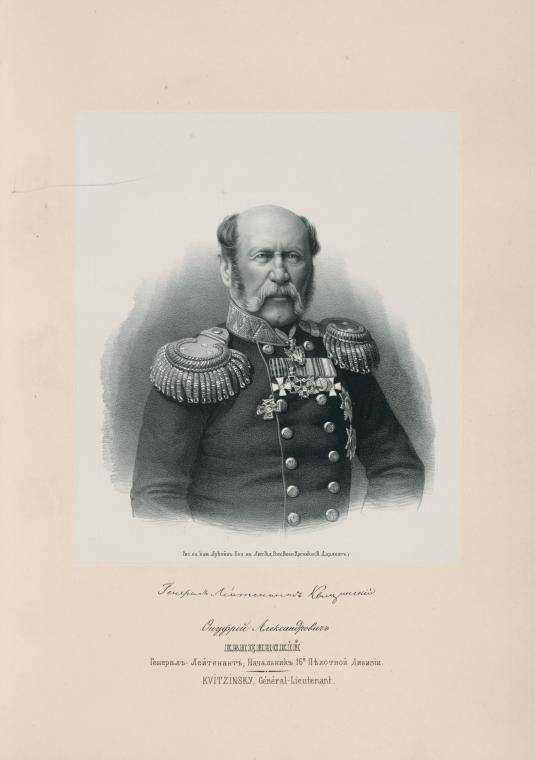
Russian General Onufry Alexandrovich Kvitsinsky (1794 — 1862)
Results
Russian troops lost 5709 people in this battle (1801 killed and 735 missing) and two or three shot down guns. The Allies lost about 3,5 thousand people (according to other sources - 4,3-4,5 thousand people).
The Union Army won, paving the way for poorly defended Sevastopol. To the main base of the Black Sea fleet the allies were in no hurry, advancing extremely slowly and carefully. They did not believe that such insignificant forces protect Crimea. They thought for a long time that they had met only the advanced corps of the Russian army.
Despite the numerical advantage of the enemy, the support of the fleet and the best small arms, military researchers believe that Menshikov could delay the enemy for a longer time and cause him serious damage. So, the question remains: whether the left flank was left unprotected deliberately on the orders of the command or was it a mistake by Kiryanov and Menshikov. It is also noted that Menshikov did not pay attention to the construction of more serious fortifications, although the position and time allowed it to be done. The interaction of the troops was poorly organized. If the Moscow, Minsk, Borodino, Kazan and Vladimir regiments met the enemy with their breasts, suffered huge losses and fiercely fought, then almost half of Menshikov’s army didn’t smell powder. Brest, Belostok, Tarutinsky and Uglitsky regiments left the battlefield, without actually using their capabilities.
Thus, not all army forces were used to deter the enemy. With a more skilled leadership, as on the right flank, the Menshikov troops had good chances to prolong the battle and cause serious damage to the enemy.
The impression made in Petersburg by the battle of Alma was huge. It was the first fight, and he had a depressing effect. Now everyone was waiting for the news of the fall of Sevastopol. Menshikov, unfortunately, did not behave in the best way and put all the blame for the defeat on the troops, who allegedly fought badly.
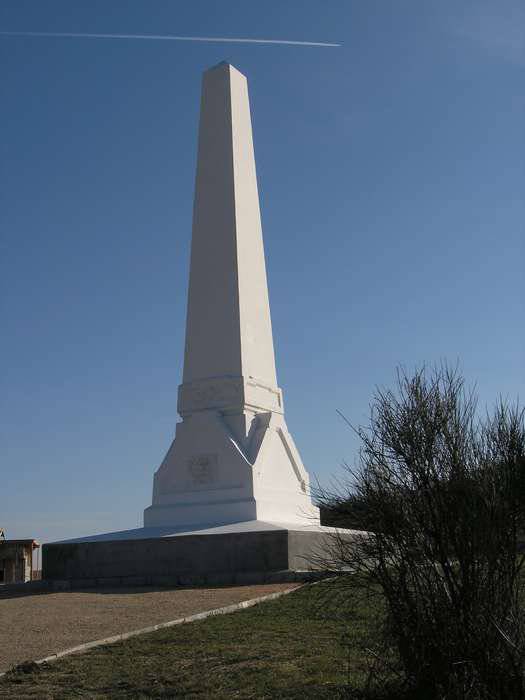
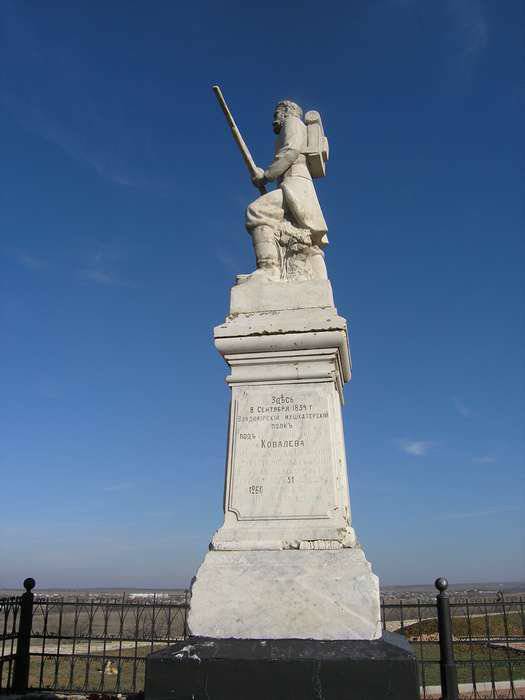
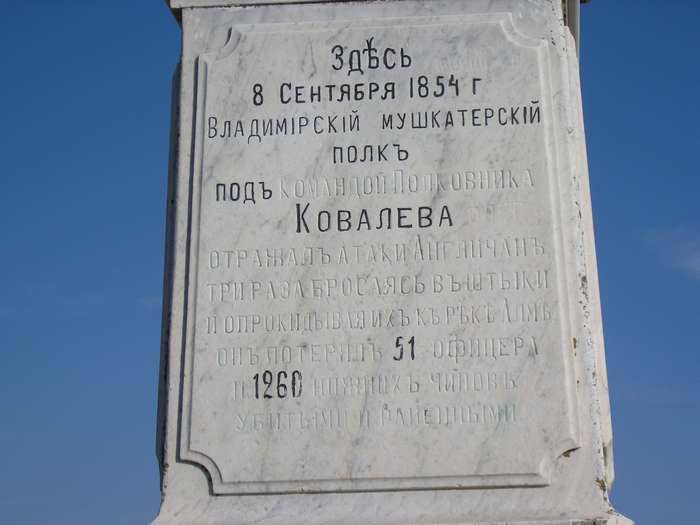
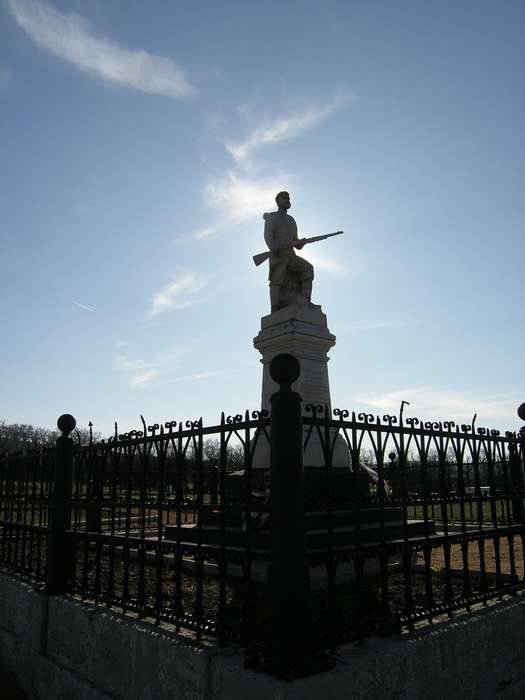
Memorial on the field of the battle of Alma. Built in honor of the soldiers who died during the most difficult battle of the Crimean War, which occurred in 1854.
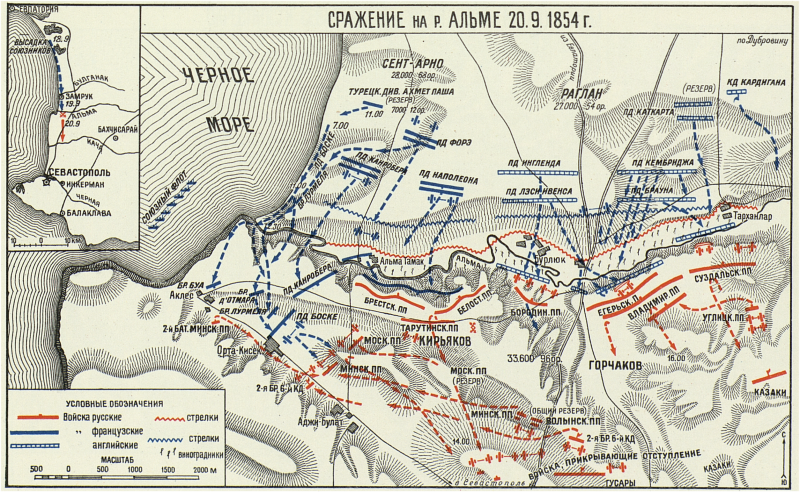
Information